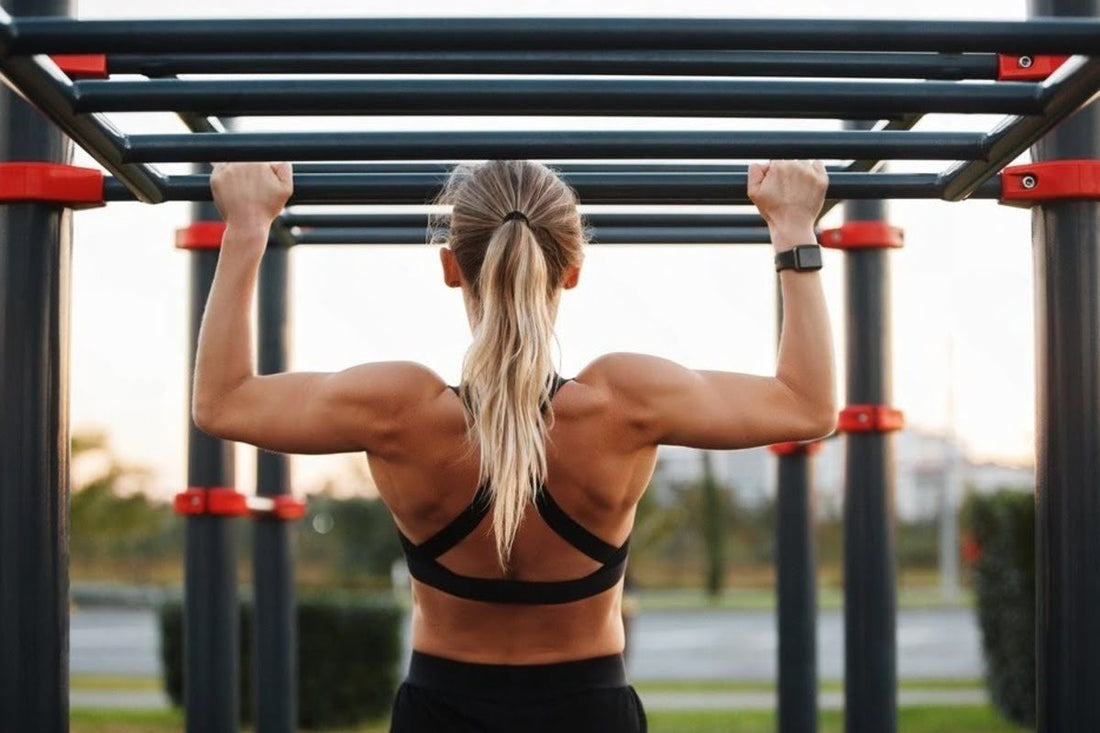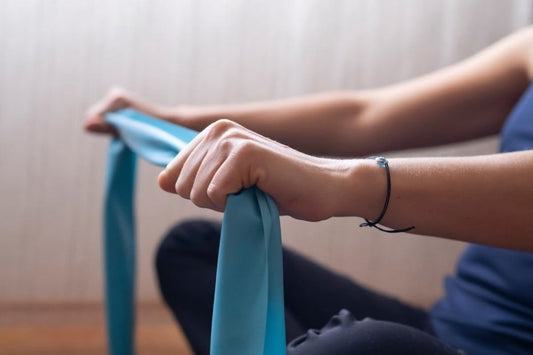Outdoor workout equipment that meets modern fitness enthusiasts’ demands must offer versatility, convenience, and effectiveness. Pull-up assist bands provide adjustable resistance suitable for beginners and advanced users alike. These elastic bands bridge the gap between indoor gym capabilities and outdoor training freedom. Their lightweight design and durable materials make them perfect for maintaining workout quality anywhere.
- 1. Pull-Up Bands for Outdoor Workouts
- 2. Top Benefits of Using Assist Bands Outdoors
- 3. How to Use Pull-Up Bands in a Park or Outdoor Gym
- 4. Pull-Up Bands vs. Other Outdoor Equipment
- 5. Choosing the Right Resistance Level for Outdoor Use
- 6. Tips for Maintaining and Storing Your Bands Outdoors
- 7. Beginner-Friendly Outdoor Pull-Up Band Routine
- 8. Summary
Pull-Up Bands for Outdoor Workouts
The outdoor environment presents unique challenges and opportunities for fitness enthusiasts. Unlike indoor gyms with their controlled climate and predictable equipment availability, outdoor workouts require adaptable and reliable outdoor workout equipment. Pull-up assist bands excel in this environment due to their inherent versatility and weather-resistant properties.
Natural outdoor settings often lack the assisted pull-up machines found in traditional gyms. This equipment gap can be frustrating for individuals working toward unassisted pull-ups or those seeking to maintain their upper body strength routine while exercising outdoors. Pull-up assist bands solve this problem by providing the same supportive function as expensive gym machines, but with the added benefit of complete portability.
The resistance provided by these bands mimics the natural movement patterns of bodyweight exercises while offering customizable assistance levels. This feature makes them particularly valuable for outdoor workouts where progression and adaptation are key. Whether you're training in a local park, on a beach, or during a camping trip, pull-up assist bands ensure your workout routine remains consistent and effective.
Outdoor workout equipment must withstand various environmental conditions, and quality pull-up assist bands are designed with this in mind. Made from durable latex or fabric materials, these bands resist UV rays, temperature fluctuations, and moisture, making them reliable companions for year-round outdoor training. Their compact size means they never become a burden during transport, yet they provide the functionality of much larger pieces of equipment.
Top Benefits of Using Assist Bands Outdoors
The advantages of incorporating pull-up assist bands into outdoor workouts extend far beyond their portability. These versatile tools offer a comprehensive range of benefits that enhance the overall outdoor fitness experience.
Progressive strength development represents one of the most significant advantages of using assist bands outdoors. The variable resistance provided by these bands allows users to gradually reduce assistance as their strength improves, creating a natural progression path toward unassisted pull-ups. This progressive approach is particularly valuable in outdoor settings where consistency and long-term development are priorities.
Joint-friendly exercise is another crucial benefit that makes pull-up assist bands ideal outdoor workout equipment. The elastic nature of the bands provides a smooth resistance curve that reduces stress on joints while maintaining muscle activation throughout the entire range of motion. This characteristic is especially important for outdoor workouts where proper warm-up facilities may be limited.
Full-body engagement is possible with pull-up assist bands, transforming them from simple pull-up assistance tools into comprehensive fitness equipment. Beyond their primary function, these bands can facilitate squats, chest presses, rows, and numerous other exercises, effectively replacing multiple pieces of traditional gym equipment. This versatility maximizes the value of outdoor workout sessions and ensures comprehensive muscle development.
The psychological benefits of using assist bands outdoors should not be overlooked. The confidence boost that comes from successfully performing pull-ups with band assistance encourages continued outdoor training and helps build the momentum necessary for long-term fitness success. This positive reinforcement cycle is particularly powerful in outdoor environments where natural settings already provide mood-enhancing benefits.
How to Use Pull-Up Bands in a Park or Outdoor Gym
Successful implementation of pull-up assist bands in outdoor settings requires understanding both proper technique and environmental considerations. Parks and outdoor gyms provide ideal venues for band-assisted training, offering sturdy anchor points and open spaces for movement.
The first step involves identifying appropriate anchor points for your outdoor workout equipment. Pull-up bars in parks and outdoor gyms provide the most obvious attachment points, but sturdy tree branches, playground equipment, and dedicated outdoor fitness stations can also serve this purpose. Always test the stability and weight capacity of any anchor point before beginning your workout routine.
Proper band attachment is crucial for both safety and effectiveness. Loop the band securely around your chosen anchor point, ensuring it sits at an appropriate height for your exercise selection. For pull-up assistance, the band should hang at approximately chest height when you're standing beneath the anchor point. Double-check all connections before placing your body weight on the equipment.
Body positioning with pull-up assist bands requires attention to form and safety. Step into the band loop, positioning it around your knees, thighs, or feet depending on the desired assistance level and band design. Maintain proper pull-up form throughout the movement, focusing on controlled ascent and descent rather than relying entirely on band assistance. The goal is to use the band as a training tool rather than a crutch.
Environmental awareness becomes particularly important when using outdoor equipment in public spaces. Be mindful of other park users, maintain appropriate social distances, and ensure your exercise routine doesn't interfere with normal park activities. Consider peak usage times and select locations that provide adequate space for safe band-assisted exercises.
Pull-Up Bands vs. Other Outdoor Equipment
The landscape of outdoor workout equipment includes numerous options, each with distinct advantages and limitations. Understanding how pull-up assist bands compare to alternative equipment helps inform decisions about the most effective outdoor fitness setup.

Portable pull-up bars offer another alternative for outdoor pull-up training. These devices provide stable anchor points but lack the progressive assistance features of pull-up bands. For users already capable of unassisted pull-ups, portable bars may suffice, but bands provide better support for skill development and strength progression.
Resistance tubes and traditional resistance bands share similarities with pull-up assist bands but typically offer less durability and fewer exercise options. Pull-up assist bands are specifically designed to handle body weight loads and provide consistent tension throughout their range of motion, making them more reliable for outdoor use.
The versatility factor strongly favors pull-up assist bands when evaluating outdoor workout equipment options. While other equipment may excel in specific applications, bands provide the broadest range of exercise possibilities while maintaining minimal size and weight requirements. This versatility becomes increasingly valuable for travelers and outdoor enthusiasts, who must carefully consider every piece of equipment they carry.
Choosing the Right Resistance Level for Outdoor Use
Selecting appropriate resistance levels for pull-up assist bands requires consideration of current fitness level, training goals, and intended outdoor applications. The resistance level directly impacts the effectiveness of your outdoor workout equipment and determines the progression path for strength development.
Light resistance bands typically provide 10-35 pounds of assistance and work well for individuals already capable of performing several unassisted pull-ups. These bands offer minimal assistance while maintaining the challenge necessary for continued strength development. Light resistance bands are ideal for outdoor workouts focused on high-repetition training or endurance building.
Medium resistance bands generally provide 40-60 pounds of assistance, making them suitable for intermediate users who can perform 1-3 unassisted pull-ups or those returning to training after a break. This resistance level strikes a balance between assistance and challenge, making it versatile outdoor workout equipment for various fitness levels and training phases.
Heavy resistance bands offer 65-100 pounds or more of assistance, providing substantial support for beginners or individuals with significant strength deficits. These bands enable proper pull-up form development while building the foundational strength necessary for progression. Heavy resistance bands ensure that outdoor workouts remain accessible and effective for users at all fitness levels.
Progressive resistance systems, featuring multiple bands of different resistances, provide the most comprehensive solution for long-term outdoor training. These systems allow users to adjust resistance levels as their strength improves, ensuring continued challenge and development. While slightly bulkier than single bands, progressive systems maximize the versatility of your outdoor workout equipment investment.
Tips for Maintaining and Storing Your Bands Outdoors
Proper care and maintenance of pull-up assist bands ensure longevity and reliable performance as essential outdoor workout equipment. Outdoor environments present unique challenges that require specific maintenance approaches to preserve band integrity and functionality.
Cleaning protocols should address the various contaminants encountered in outdoor settings. After each outdoor workout session, inspect bands for dirt, debris, sand, or other particles that could cause premature wear. Use mild soap and water to clean bands thoroughly, paying particular attention to areas that contact anchor points or your body. Allow bands to dry completely before storage to prevent bacterial growth and material degradation.
UV protection represents a critical consideration for outdoor workout equipment longevity. Extended exposure to direct sunlight can weaken elastic materials over time, reducing band effectiveness and lifespan. When possible, conduct workouts in shaded areas or during times of reduced UV intensity. Store bands in UV-protective cases or containers when not in use, and avoid leaving them exposed to direct sunlight for extended periods.
Temperature considerations affect both band performance and longevity. Extreme heat can cause bands to become overly elastic and potentially unsafe, while extreme cold can make them brittle and prone to breakage. Allow bands to acclimate to ambient temperature before use, and avoid storing them in vehicles or other locations subject to temperature extremes.
Storage solutions for outdoor workout equipment should prioritize protection while maintaining portability. Dedicated band storage bags or containers protect against UV exposure, moisture, and physical damage while keeping multiple resistance levels organized and accessible. Consider storage solutions that integrate with your existing outdoor gear to minimize bulk and complexity.
Regular inspection routines help identify potential issues before they compromise safety or performance. Check bands for nicks, cuts, thin spots, or other signs of wear before each use. Pay particular attention to areas that experience high stress, such as attachment points and sections that contact rough surfaces. Replace damaged bands immediately to maintain safety standards and workout effectiveness.

Beginner-Friendly Outdoor Pull-Up Band Routine
Developing an effective outdoor workout routine with pull-up assist bands requires understanding proper progression, exercise selection, and safety considerations. This beginner-friendly routine provides a foundation for building strength and confidence while enjoying outdoor fitness activities.
Warm-up preparation becomes particularly important when using outdoor workout equipment in varying environmental conditions. Begin each session with 5-10 minutes of light cardio activity such as walking or jogging to increase core body temperature and prepare muscles for resistance training. Follow cardio warm-up with dynamic stretching focusing on shoulders, arms, and back muscles that will be engaged during band-assisted exercises.
The primary pull-up progression forms the cornerstone of any band-assisted routine. Begin with 3 sets of 5-8 assisted pull-ups, focusing on proper form rather than repetition count. Lower yourself slowly and controlled, taking 3-4 seconds for the descent phase. Rest 60-90 seconds between sets to allow adequate recovery while maintaining workout momentum.
Supplementary exercises expand the effectiveness of your outdoor workout equipment beyond simple pull-up assistance. Incorporate band-assisted inverted rows by attaching the band to a lower anchor point and leaning back at approximately 45 degrees. Perform 2 sets of 8-12 repetitions to strengthen the pulling muscles from a different angle and improve overall upper body development.
Upper body pushing movements create balanced development when using pull-up assist bands as outdoor workout equipment. Use the band for assisted push-ups by looping it around your torso and anchoring it above your head. This variation reduces the load while maintaining proper movement patterns. Complete 2 sets of 8-15 repetitions depending on your current strength level.
Lower body integration maximizes the versatility of your outdoor workout routine. Use pull-up assist bands for supported squats, lunges, and lateral movements. The band assistance helps maintain proper form while building lower body strength and endurance. Incorporate 2-3 lower body exercises for 10-15 repetitions each to create a comprehensive outdoor workout session.
Cool-down and recovery protocols ensure optimal results from your outdoor workout equipment usage. Conclude each session with 5-10 minutes of static stretching, focusing on the muscles worked during your routine. Pay particular attention to shoulders, lats, and biceps, which receive significant stimulation during band-assisted pull-up training. Proper cool-down promotes recovery and prepares your body for future outdoor training sessions.
Summary
Pull-up assist bands redefine outdoor workout equipment by combining versatility, effectiveness, and convenience for all fitness levels. These simple yet powerful tools provide the support and progression needed to build strength anywhere with available anchor points. For those serious about consistent training, pull-up assist bands are more than recommended—they’re essential companions for reaching fitness goals outdoors.










